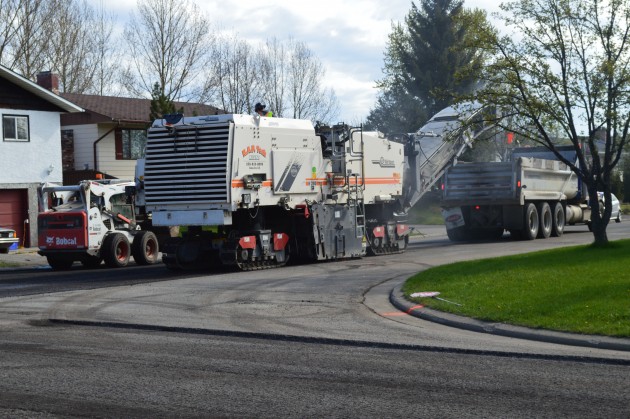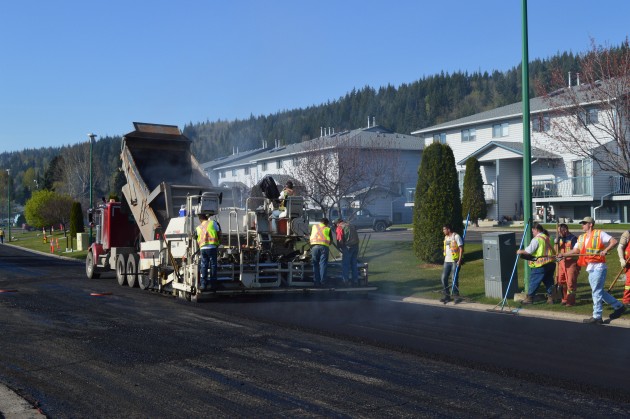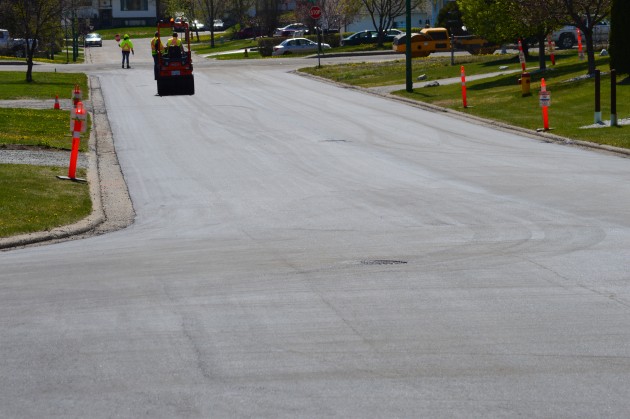Cap On Some City Streets Called Into Question
Prince George, B.C. – The City’s 2015 road rehabilitation projects are underway with the first seven jobs on the list to be completed, weather permitting, by next Thursday, May 14th.
A good portion of the 2014 road work concentrated on getting the main routes and thoroughfares done in advance of the city hosting the 2015 Canada Winter Games the last two weeks of February. That meant many of the streets in residential and secondary areas were left off the list last year and are being rehabilitated this year.
Crews working for Pittman on this year’s projects have made an interesting discovery, one acknowledged by City Hall. And that is that the cap above the road bed on some of these streets is, in some cases, drastically below the thickness dictated by today’s standard. As an example, it has been pointed out that the cap on certain spots on Killoren Crescent in the Heritage area is perhaps 30 to 35 millimetres thick when the standard now is about 65 millimetres.
The Supervisor of Streets Operations with the City, Mick Jones, says “you are correct and I don’t have an answer for it, I can’t explain it, I don’t know why, but when we get onto some of these older roads we find that they are not even close to what should be there. And after they did Killoren they went down to Ewert and we found less than an inch of asphalt in spots.”
Jones says “the City’s minimum standard on a local road is 65 millimetres. On arterial and collectors it can be anywhere between 75 and 100. So on 15th and Ospika and all the major roads we don’t run into these problems usually because there’s lots of asphalt there. But a lot of these residential streets, for whatever reason, I don’t know what it was, I don’t know if it was just a lack of volume control, I have no idea.”
“But we find that more often than not on the side streets where we blow through. Like where we do the milling we try to remove enough so that it can bite into the curb and then we’ve got enough but we’re trying to add more structure at the same time. Because we’re always finding on some of these side roads that there’s not enough there and maybe that’s why they’re in such poor condition, because there’s not enough there, so we always try to add more.”
Jones says “the whole point of the milling is to remove as much of the asphalt distresses that we can, but knowing that there’s probably not as much mix as there should be on some of these side roads we just try to do the edges and then overlay and put more on, just so we have more road structure.”
That slows deterioration and, says Jones, “basically it increases the grade of the roads so that the water gets into the gutters better. That’s the biggest thing, water on the roads contributes to a lot of the problems so if we can get the water to the gutters, we’re better off. But it is not uncommon to find less than our current standard on some of these older roads.”
He says this discovery won’t affect or prolong the road rehab schedule for the year. He adds, “the biggest challenge is we go in with a plan and a budget for that plan and then when we run into gravel we put more asphalt back to make sure we’re getting close to our standard. But at the same time, if the project was estimated to go in and put 50 mills of asphalt, where we blow through and try to add some it puts us closer to budget.” Jones adds that there is not a threat of going over budget “because each budget has a contingency, so then we end up using the contingencies on these sorts of issues.”
“So it’s not the end of the world, it’s just more frustrating. I don’t know what happened back then, that was before my time and you just don’t know how some of the stuff was done the way that it was back then.” He says it may have to do with lower standards in the past. “That’s part of it but also I don’t think there ever would have been a standard of an inch of asphalt. So I don’t know how it would have been acceptable.”
Jones reiterates that 65 millimetres is the minimum asphalt thickness on a local road within the city of Prince George but adds “on any project where we’re working off gravel we go with at least 75, just for a little extra. It costs a little bit more but in the end more asphalt is better to increase road structure.”
“If we’re just doing an overlay on existing asphalt, we’ll go as thin as 40 millimetres and we’re still adding road structure to what’s there. But usually on the ones where we’re doing milling, like a straight mill like we did on Foothills, we put back exactly what we take off. Grind off 50 millimetres, put 50 back. That’s most common on the roads where there are islands because then you’ve got a gutter on both sides.”
“Like on Killoren Crescent, because it’s just a road with gutters on both sides, we can mill the curb edges and then we put more asphalt back, it creates a little steeper slope to the gutters. You’re building it up more in the middle than you are on the edges and all it does is get the water to the gutter quicker. It doesn’t create a challenge to traffic or anything like that.”
The City is spending $7 million on 51 road resurfacing and 16 sidewalk rehabilitation projects in 2015.




Comments
If the cap isn’t what it should be then somebody has some splainin to do!
I’m sure that some will blame the unions for this though.
What do the unions have to do with road thickness all ashpalt is contracted out and tenders put out by the city and its up to the city inspectors to make sure the grade is up to par and that is usually done by management not union people.
Good article. This helps explain why so many of our roads are in such poor shape. We need more accountability like this on how our tax dollars are being spent. Please keep up the good work 250!
Exactly if the contract was let by the city where exactly was the supervision and inspection they are directly responsible for. As usual the “spokesperson” Has no answers whatsoever and nobody at the city will offer any or be held responsible.
Im sure that all the records in regards to these streets, the contractors, etc; are on file at City Hall. Shouldn’t be hard to find out who did what, when.
I’m still a firm believer that the graders in the winter do most of the damage. Way too much pressure scraping hard on that cold brittle asphalt has to be doing something to it.
Pg,an..the graders have skids so they don’t hurt the roads..
As for this cap crap.. They did my street last year.. Said it would be two days of no parking or driving, ended up being a week.. And they also left the drains covered so tha weekend after they finished we got some rain and we had a few huge swimming pools to deal with until we unplugged the drains ourselves.. Also we have around 30 mm thick on our road..but did make it look better, how long it lasts who knows…
So did the city get billed for asphalt not used? Inspectors paid to look the other way?
Obviously somebody signed off on work done that was not in accordance with agreed upon minimum specifications. Perhaps Brian Skakun can look into this, as he is the one who has called attention to paving problems before! Poor quality asphalt plus half the specified thickness = taxpayers taken to the cleaners accidentally?
This is pitman second year on the contract Unlikely it was them that short changed us No Green conspiracy this time Pretty sure the contractor they replaced was the go to guy for a couple of decades In fact Pitman bid was so much lower than the other guy we were able to pave more road If anything this is one thing Green did right
If it wasn’t paved to spec it can’t be considered done right…..
But do we know what the spec was in the old contracts?
most of these side roads that they are doing now, have never be re-capped.
what they are dealing with is the original asphalt from 30 to 40 years ago!
Back in those days the city was developing 500 to 1000 lots a year, so you can imagine the lane miles of brand new road that way being built and paved.
I would suspect that the paving contractor of the day only met the specs in the areas that were being spot checked, and then re-set the thickness at the paver for the rest. Not that difficult to do when you are wining, and dining the inspectors on a regular basis and they give you a heads up as to when and where they will be doing their quality and quantity control checks!
And my apologies to all the Green conspiracy theorists….I’m pretty sure this dates back to when Elmer Mercier, and John Backhouse were in office!
P Val: The graders don’t have ‘skids’ on them, the plow trucks do though on their front plows. The under body plows, no.
There a quite a few places around town where you can see gouges from grader ice blades. That’s when they were bearing down too hard.
Givemore.. You are right..I was thinking of plow trucks..thanks
great were getting some of the roads repaved , wonder when they will finally get that patch on 1st ave done that has been gravel since it was dug up back in the winter ?
That sure went over your head Dearth!
Comments for this article are closed.